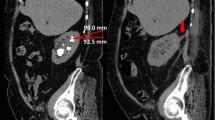Abstract
Purpose
To evaluate the safety and efficacy of stentless pediatric ureteroscopic holmium laser stone disintegration without gravels retrieval.
Patients and methods
From Feb 2007 to Feb 2010, 21 children (12 boys and 9 girls) with unilateral single stone ureter, with an average age of 8.5 years (range 4–12 years), were treated with 6.9 Fr semirigid ureteroscope for a stone size ranged from 5 to 10 mm (mean 6.5 mm). All the stones were radioopaque, located in the upper ureter in 2 cases (9.5%), in the middle ureter in 5 cases (24%), and in the lower ureter in 14 cases (66.5%). Complete holmium laser stone disintegration was applied in all cases without gravels removal. No postoperative ureteral stent was inserted in any case.
Results
The stones were successfully approached and completely disintegrated in a single session in 20 cases (95.2%). All the procedures were done without ureteral orifice dilatation apart from 3 cases where another working guide wire was applied. No intraoperative complications were recorded in the form of mucosal injury, ureteral perforation, or urinary extravasation. There is no early postoperative complication in the form of urinary tract infection or colic apart from single case of hematuria which was successfully treated conservatively. Two weeks postoperatively, KUB (kidney, ureter, and bladder) films were completely free from any significant gravel (>3 mm) and US showed no hydronephrosis.
Conclusion
Stentless ureteroscopic holmium laser disintegration without gravels removal is a safe and effective method for pediatric ureteral stone less than 10 mm in diameter.
Similar content being viewed by others
References
Lesani OA, Palmer JS (2006) Retrograde proximal rigid ureteroscopy and pyeloscopy in prepubertal children: safe and effective. J Urol 176:1570–1573
Erturhan S, Yağci F, Sarica K (2007) Ureteroscopic management of ureteral calculi in children. J Endourol 21:397–400
Satar N, Zeren S, Bayazit Y, Aridoğan IA, Soyupak B, Tansuğ Z (2004) Rigid ureteroscopy for the treatment of ureteral calculi in children. J Urol 172:298–300
De Dominicis M, Matarazzo E, Capozza N, Collura G, Caione P (2005) Retrograde ureteroscopy for distal ureteric stone removal in children. Br J Urol 95:1049–1052
Gupta PK (2007) Is the holmium: YAG laser the best intracorporeal lithotripter for the ureter? A 3-year retrospective study. J Endourol 21:305–309
Ritchey M, Patterson DE, Kelalis PP, Segura JW (1988) A case of pediatric ureteroscopic lasertripsy. J Urol 139:1272–1274
Raza A, Smith G, Moussa S, Tolley D (2005) Ureteroscopy in the management of pediatric urinary tract calculi. J Endourol 19:151–158
El-Assmy A, Hafez AT, Eraky I, El-Nahas AR, El-Kappany HA (2006) Safety and outcome of rigid ureteroscopy for management of ureteral calculi in children. J Endourol 20:252–255
Gofrit ON, Pode D, Meretyk S, Katz G, Shapiro A, Golijanin D et al (2001) Is the pediatric ureter as efficient as the adult ureter in transporting fragments following extracorporeal shock wave lithotripsy for renal calculi larger than 10 mm? J Urol 166:1862–1864
Muslumanoglu AY, Tefekli A, Sarilar O, Binbay M, Altunrende F, Ozkuvanci U (2003) Extracorporeal shock wave lithotripsy as first line treatment alternative for urinary tract stones in children: a large scale retrospective analysis. J Urol 170:2405–2408
Teichman JMH, Vassar GJ, Bishoff JT, Bellman GC (1998) Holmium: YAG lithotripsy yields smaller fragments than pulsed dye, Lithoclast or electrohydraulic lithotripsy. J Urol 159(1):17–23
Smaldone MC, Cannon GM Jr, Wu HY, Bassett J, Polsky EG, Bellinger MF, Docimo SG, Schneck FX (2007) Is ureteroscopy first line treatment for pediatric stone disease? J Urol 178:2128–2131
Thomas R, Ortenberg J, Lee BR et al (1993) Safety and efficacy of pediatric ureteroscopy for management of calculous disease. J Urol 149:1082–1084
Herndon CDA, Viamonte L, Joseph DB (2006) Ureteroscopy in children: is there a need for ureteral dilation and postoperative stenting? J Pediatr Urol 2:290–293
Thomas JC, DeMarco RT, Donohoe JM, Adams MC, Brock JW III, Pope JC 4th (2005) Pediatric ureteroscopic stone management. J Urol 174:1072–1074
Schuster TG, Russell KY, Bloom DA, Koo HP, Faerber GJ (2002) Ureteroscopy for the treatment of urolithiasis in children. J Urol 167:1813–1816
Minevich E, Defoor W, Reddy P, Nishinaka K, Wacksman J et al (2005) Ureteroscopy is safe and effective in prepubertal children. J Urol 174:276–279
Author information
Authors and Affiliations
Corresponding author
Rights and permissions
About this article
Cite this article
Gamal, W., Aldahshoury, M., Hammady, A. et al. Stentless pediatric ureteroscopic holmium: YAG laser stone disintegration: is gravels retrieval an issue?. Int Urol Nephrol 43, 613–617 (2011). https://doi.org/10.1007/s11255-011-9908-y
Received:
Accepted:
Published:
Issue Date:
DOI: https://doi.org/10.1007/s11255-011-9908-y



